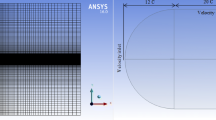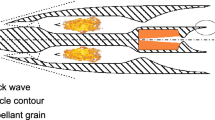Abstract
This paper is concerned with experimental and numerical research on 3D flow past prismatic turbine cascade SE1050 (known in QNET network as open test case SE1050). The primary goal was to assess the influence of the inlet velocity profile on the flow structures in the interblade channel and on the flow field parameters at the cascade exit and to compare these findings to results of numerical simulations. Investigations of 3D flow past the cascade with non-uniform inlet velocity profile were carried out both experimentally and numerically at subsonic (M 2is = 0.8) and at transonic (M 2is = 1.2) regime at design angle of incidence. Experimental data was obtained using a traversing device with a five-hole conical probe. Numerically, the 3D flow was simulated by open source code OpenFOAM and in-house code. Analyses of experimental data and CFD simulations have revealed the development of distinctive vortex structures resulting from non-uniform inlet velocity profile. Origin of these structures results in increased loss of kinetic energy and spanwise shift of kinetic energy loss coefficient distribution. Differences found between the subsonic and the transonic case confirm earlier findings available in the literature. Results of CFD and experiments agree reasonably well.
Similar content being viewed by others
Abbreviations
- AR :
-
aspect ratio (1)
- c :
-
chord (m)
- E :
-
specific total internal energy (J/kg)
- h :
-
specific enthalpy (J/kg)
- H :
-
specific total enthalpy (J/kg), shape parameter
- k :
-
turbulent kinetic energy (m/s)2
- L :
-
width of the test section (m)
- M :
-
Mach number (1)
- M*:
-
nondimensional velocity (related to the critical speed of sound) (1)
- N :
-
number of blades (1)
- o :
-
throat opening (m)
- p :
-
static pressure (Pa)
- p t :
-
total pressure (Pa)
- s :
-
pitch (m)
- u j :
-
components of velocity vector (m/s)
- x :
-
coordinate (m)
- y :
-
coordinate (m)
- z :
-
coordinate (m)
- α :
-
flow angle (°)
- α eff :
-
effective thermal diffusivity (m2/s)
- β :
-
metal angle (°)
- γ :
-
stagger angle (°)
- δ :
-
boundary layer thickness (m)
- δ*:
-
boundary layer displacement thickness (m)
- ζ :
-
kinetic energy loss coefficient (1)
- ι:
-
incidence angle (°)
- ρ :
-
density (kg/m3)
- θ :
-
boundary layer momentum thickness (m) effective stress tensor including the viscous and
- τ ij eff :
-
Reynolds stress tensors (Pa)
- φ:
-
flow turning (°)
- ω :
-
turbulent frequency (1/s)
- 1:
-
blade cascade inlet
- 2:
-
blade cascade outlet
- is:
-
isentropic
- ref:
-
reference value
References
Sieverding, C. H.: Recent Progress in the Understanding of Basic Aspects of Secondary Flows in Turbine Blade Passages, ASME J. Turbomach., Vol. 107, pp.249–257, (1985).
Langston, L. S.: Secondary Flows in Axial Turbines — A Review, Annals of the New York Academy of Sciences, 943, pp.11–26, (2001).
Lampart, P.: Investigation of Endwall Flows and Losses in Axial Turbines. Part I. Formation of Endwall Flows and Losses, J. of Theoretical and Applied Mechanics, 47,2, pp.321–342, (Warsaw, 2009).
Hodson, H. P., Dominy, R. G.: The Off-Design Performance of a Low-Pressure Turbine Cascade, ASME J. Turbomach. Vol. 109, pp. 201–209, (1987).
Moore, J., Shaffer, D. M., Moore, J. G.: Reynolds Stresses and Dissipation Mechanisms Downstream of a Turbine Cascade, ASME J. Turbomach. Vol. 109, pp. 258–267, (1987).
Lampart, P.: Investigation of Endwall Flows and Losses in Axial Turbines. Part II. The Effect of Geometric and Flow Parameters, J. of Theoretical and Applied Mechanics, 47,4, pp.829–858, (Warsaw, 2009).
Perdichizzi, A.: Mach Number Effects on Secondary Flow Development Downstream of a Turbine Cascade, ASME J. Turbomach., Vol. 112, pp.642–651, (1990).
Michelassi, V., Rodi, W., Gieb, P. A.: Experimental and Numerical Investigation of Boundary-Layer and Wake Development in a Transonic Turbine Cascade, Aerospace Science and Technology, 2(3), pp.191–204, (1998).
Biswas, G., Eswaran, V.: Turbulent Flows: Fundamentals, Experiments and Modeling, CRC Press, Boca Raton, FL, Chap. 15, (2002).
Harrison, S.: Secondary Loss Generation in a Linear Cascade of High-Turning Blades, ASME Paper 89-GT-47, Toronto, Canada, (1989).
Pecnik, R., Pieringer P., Sanz, W.: Numerical Investigation of the Secondary Flow of a Transonic Turbine Stage Using Various Turbulence Closures, ASME Paper GT2005-68754, Reno-Tahoe, USA, (2005).
Hjärne, J., Larsson, J., Chernoray, V., Lofdahl, L.: Numerical Validations of Secondary Flows and Loss Development Downstream of a Highly Loaded Low-Pressure Turbine Outlet Guide Vane Cascade, ASME Paper GT2007-27712, Montreal, Canada, (2007).
Příhoda, J., Kozel, K.: ERCOFTAC Q-NET CFD url: http://qnet-ercoftac.cfms.org.uk/w/index.php/Silver:AC_6-12_Description, (2004).
Šťastný, M., Šafařík, P.: Experimental Analysis Data on the Transonic Flow Past a Turbine Cascade, ASME Paper 90-GT-313, Brussels, Belgium, (1990).
Amecke, J., Šafařík, P.: Data Reduction of the Wake Flow Measurements with Injection of an Other Gas, Forschungsbericht DLR, rep. nr. 95-32, Goettingen, Germany, (1995).
Matějka, M., Šafařík, P., Luxa, M., Šimurda, D., Synáč, J.: Loss Coefficient Dependence of Turbine Blade Cascade, ASME Paper GT2010-22740, Glasgow, UK, (2010).
Luxa, M., Synáč, J., Šafařík, J., Šimurda, D.: Causes and solution of aperiodicity of supersonic flow field downstream of a profile cascade, Communications, Vol. 14,4a, pp. 23–28, (2012).
Ferziger, J. H., Perics, M.: Computational Methods for Fluid Dynamics, Springer, Berlin, Heidelberg, New York, (2001).
Menter, F., R., Kuntz, M., and Langtry, R., Ten Years of Industrial Experience with the SST Turbulence Model, Turbulence, Heat and Mass Transfer 4, ed: K. Hanjalic, Y. Nagano, and M. Tummers, Begell House, Inc., Antalya, Turkey, pp. 625–632, (2003).
Fürst, J.: A weighted least square scheme for compressible flows, J. Flow Turbulence and Combustion, Vol 76, No 4, pp 331–342, (2006).
Smart, M.K., Kalkhoran, I.M.: The Effect of Shock Strength on Oblique Shock Wave-Vortex Interaction, AIAA Journal, 33,11, pp 2137–2143, (1995).
Sforza, P.M.: Shock-Vortex Interaction Research, Fluid Dynamics Research on Supersonic Aircraft, NATO Research and Technology Organization AVT/VKI Special Course, Brussels (1998).
Author information
Authors and Affiliations
Additional information
This research was supported by the Czech Science Foundation under the grant No. GAP 101/10/1329.
Rights and permissions
About this article
Cite this article
Šimurda, D., Fürst, J. & Luxa, M. 3D flow past transonic turbine cascade SE 1050 — Experiment and numerical simulations. J. Therm. Sci. 22, 311–319 (2013). https://doi.org/10.1007/s11630-013-0629-7
Received:
Published:
Issue Date:
DOI: https://doi.org/10.1007/s11630-013-0629-7




